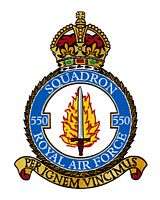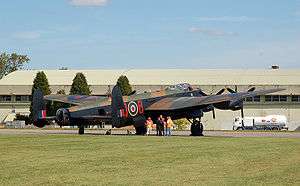No. 550 Squadron RAF
No. 550 Squadron RAF was a heavy bomber squadron of the Royal Air Force during World War II. Formed at RAF Waltham on 25 November 1943, 550 Squadron flew Avro Lancaster bombers as part of No. 1 Group RAF. In early 1944, the squadron was moved to RAF North Killingholme, Lincolnshire where it continued operations until May 1945, when it began dropping food over the Netherlands as a relief effort as part of Operation Manna. The squadron was disbanded on 31 October 1945. Today, a surviving Lancaster bomber continues to fly in the markings of BQ-B "Phantom of the Ruhr" EE139 from 550 squadron as part of the Battle of Britain Memorial Flight.
| No. 550 Squadron RAF | |
|---|---|
 Insignia of 550 Squadron | |
| Active | 25 Nov 1943 – 31 Oct 1945 |
| Country | |
| Branch | |
| Role | Bomber |
| Motto(s) | Latin: Per Ignem Vincimus (Translation: "Through fire we conquer")[1][2] |
| Insignia | |
| Squadron Badge heraldry | In front of flames of fire a sword erect point upwards.[2] The badge is symbolic of the squadron's power to force its way through barrage of fire and fighter opposition to drop its bombs. It can also be taken as symbolic of the squadron's raids with both incendiary and high-explosive bombs.[1] |
| Squadron Codes | BQ (Nov 1943 – Oct 1945)[3][4] |
| Aircraft flown | |
| Bomber | Avro Lancaster Four-engined heavy bomber |
History
Operation Banquet
Before standing up as an operational bomber unit 550 Squadron was allocated to the Air Fighting Development Unit under 'Operation Banquet' anti-invasion plans.[5]
Formation at RAF Waltham

No. 550 squadron was formed at RAF Waltham (near Grimsby), Lincolnshire on 25 November 1943 from 'C' Flight of 100 Squadron.[6] Equipped with Avro Lancasters, they began operating in the same month, as part of No. 1 Group RAF. The squadron's commanding officer, until 17 May 1944, was Wing Commander James Johnson Bennett.[7] The squadron motto was "Per Ignem Vincimus", meaning "through fire we conquer".
From RAF Waltham, 550 Squadron attacked Berlin on seven occasions, and also participated in raids on Leipzig and Frankfurt. [8] On 26/27 November 1943, 8 of their Lancasters were dispatched to make bombing runs over Berlin; 7 succeeded, with the other failing to return after the mission.[9]
RAF Killinghome
On 3 January 1944 the squadron was moved to RAF North Killingholme, Lincolnshire, where it continued operations. 550 flew their first mission from North Killingholme on 14 January 1944 - 11 Lancasters participated in a raid on Brunswick. [8]
550 grew in size to two flights and later to three. 550 Squadron would become one of the most efficient squadrons in Bomber Command, on a number of occasions reaching the top of the No. 1 Group RAF Group bombing league table. Losses were relatively low, as was the rate of aborted missions - a good indication of high morale. [8]
From January 44 until 26 May 1945 the squadron adjutant was Christopher Walter Waitt, who had served with the Royal Flying Corps in WW1 and had been awarded the Military Medal. [10]
On 5 June 1944 550 Squadron participated in the D-Day landings, as Lancaster LL811 J-Jig "Bad Penny II" was credited with dropping the first string of bombs at 11.34pm. [8]
On 25 April 1945 550 Squadron flew their last combat mission of the war - 23 Lancasters participated in the Bombing of Obersalzberg.[8]
During the course of the war, 550 Squadron completed 3,582 operational sorties with the Lancaster with the loss of 59 aircraft.[11] The squadron dropped 16,195 tons of bombs.[8] Three of 550 Squadron's Lancaster bombers succeeded in flying more than 100 combat missions. These were BQ-F "Press on Regardless" ED905, BQ-V 'The Vulture Strikes' PA995, and - the most well known - BQ-B "Phantom of the Ruhr" EE139. The latter flew a total of 121 missions. [8]
550 Squadron dropped food over the Netherlands as a relief effort as part of Operation Manna, which took place from 29 April to 7 May 1945.[9]
After the war

Germany surrendered on 8 May 1945. 550 Squadron was disbanded at North Killingholme on 31 October 1945.,[2] the same day that North Killinghome closed.[12]
Today, the Battle of Britain Memorial Flight Lancaster is painted in the colours of BQ-B "Phantom of the Ruhr" EE139.[8]
Aircraft operated
| From | To | Aircraft | Version |
|---|---|---|---|
| November 1943 | October 1945 | Avro Lancaster | Mks.I, III |
Notable aircraft
Three of the Lancasters that flew with 550 Squadron managed to survive one hundred operations or more, and one nearly did so:
| Serial no. | Name | Operations | Call-sign | Fate | Remarks |
|---|---|---|---|---|---|
| EE139 | "Phantom of the Ruhr" | 121 | BQ-B | Scrapped 19-02-1946 | Also flew with No. 100 Squadron RAF. Current Battle of Britain Memorial Flight Lancaster flies BQ-B call-sign.[14] |
| PA995 | "The Vulture Strikes" | 101 | BQ-V | Failed to return, 11-03-1945 | Flew all missions with 550 Squadron[15] |
| ED905 | "Ad Extremum/Press on Regardless" | 100+ | BQ-F | Crashed 20-08-1945 with No. 1656 Conversion Unit | Also flew with No. 103 Squadron RAF and No. 166 Squadron RAF[16] |
| W5005 | "SS-Nan" | 94 | BQ-N | Ditched in Humber Estuary 26/27-08-1944 | Also flew with No. 460 Squadron RAAF |
Squadron bases
| From | To | Base |
|---|---|---|
| 25 November 1943 | 3 January 1944 | RAF Waltham, Lincolnshire |
| 3 January 1944 | 31 October 1945 | RAF North Killingholme, Lincolnshire |
References
Notes
- Moyes 1976, p. 267.
- Halley 1988, p. 411.
- Bowyer and Rawlings 1979, p. 23.
- Flintham and Thomas 2003, p. 65.
- Lake, Alan (1999). Flying Units of the RAF. Shrewsbury: Airlife Publishing. ISBN 1-84037-086-6.
- Jefford 2001, p. 98.
- www.550squadronassociation.org.uk Retrieved 5 June 2019
- Official History Retrieved 6 June 2019
- Moyes 1976, p. 268.
- Officers of 550 Squadron Retrieved 6 June 2019
- Falconer 2003, p. 255.
- "History of 550 Squadron". 550 Squadron and North Killingholme Association. 2015. Retrieved 19 October 2015.
- Moyes 1976, p. 362.
- Franks 1994, pp. 9–96.
- Franks 1994, pp. 199–202.
- Franks 1994, pp. 79–84.
Bibliography
- Bowyer, Michael J.F.; John D.R. Rawlings (1979). Squadron Codes, 1937–56. Cambridge, UK: Patrick Stephens Ltd. ISBN 0-85059-364-6.
- Falconer, Jonathan (2003). Bomber Command Handbook 1939–1945. Stroud, England: Sutton Publishing. pp. 203–204. ISBN 0-7509-3171-X.
- Flintham, Vic; Andrew Thomas (2003). Combat Codes: A full explanation and listing of British, Commonwealth and Allied air force unit codes since 1938. Shrewsbury, Shropshire, UK: Airlife Publishing Ltd. ISBN 1-84037-281-8.
- Franks, Norman (1994). Claims to Fame: The Lancaster. London: Arms and Armour Press. ISBN 1-85409-220-0.
- Halley, James J. (1988). The Squadrons of the Royal Air Force & Commonwealth, 1918–1988. Tonbridge, Kent, UK: Air-Britain (Historians) Ltd. ISBN 0-85130-164-9.
- Jefford, Wing Commander C.G. (2001). RAF Squadrons, a Comprehensive record of the Movement and Equipment of all RAF Squadrons and their Antecedents since 1912. Shrewsbury, Shropshire, UK: Airlife Publishing Ltd. ISBN 1-85310-053-6.
- Moyes, Philip J.R. (1976). Bomber Squadrons of the RAF and their Aircraft. London: Macdonald and Jane's (Publishers) Ltd. ISBN 0-354-01027-1.
- Lake, Alan (1999). Flying Units of the RAF. Shrewsbury: Airlife Publishing. ISBN 1-84037-086-6.
External links
| Wikimedia Commons has media related to No. 550 Squadron RAF. |
